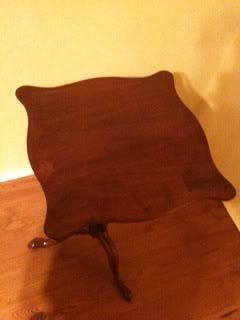A Curious Little Table
I paid a visit to the Baltimore Museum of Art this past weekend. I had heard tales of their excellent decorative arts wing that contains excellent examples of 18th century furniture with an emphasis on local cabinetmakers from Baltimore and Annapolis. Unfortunately on my way down the hall to the exhibit I was told by a docent that they were closing that wing due to a shift change in guards and no longer had the manpower to keep that wing open. I understand this is a product of a recessive economy and the museum just not being able to employ the number of guards necessary. It was understandably disappointing but I was directed to some other parts of the museum where I could see furniture. Surprisingly I saw a great deal so I can only imagine what the dedicated decorative arts wing must look like. Stay tuned for that report later as I am chomping at the bit to go back.
Ironically the piece that sticks in my head the most was shuffled off to the side of an exhibit and I only noticed it because I was assuming the role of husband waiting for his wife outside the restroom. Behind and to the side of a pretty Queen Anne dining chair was this curious little table.

While it was still an exhibit meaning I couldn’t touch it, I was able to get very close and take some snapshots and sketch some of the curves. This later point provoked some rolled eyes as the aforementioned wife left the restroom. There are hundreds and hundreds of these little candle stands sprinkled throughout period furniture exhibits, but this one particularly caught my attention because of it’s simplicity. The turned central column is not overly detailed and it represents the truest essence of the Queen Anne style that I like so much. There isn’t a wide flare into a bulbous base that is so common in this form but a gradual widening that terminates in a small bead. This whole shape adds a very delicate feeling to the table which seems to support the beautifully shaped top as if it were weightless. This is an interesting contrast to the tripod feet that snake down and firmly plant themselves. Many of the designs I have seen like this seem to stand on tip toe but this one has it’s heels planted and I like the curve formed at the ankle because of it. This speaks to the Queen Anne style as well since this was really before the ubiquitous ball and claw came into vogue.

I took a shot up under the table as best I could and confirmed that it wasn’t a tilt top (that would be unusual for such a small piece) but I also want to confirm the joinery points as I was already mentally marking out a piece of Walnut that was sitting back in my shop.

Here is a better shot of the top profile with it’s Porringer-esque shape that beckons you to set your drink there and settle down in your Windsor chair with a good book.
I think this very simple piece embodies much of what I admire about the Queen Anne period and it will definitely get a place on my “to build” project list. The challenge of dovetailing the feet into the central column is something I look forward to as well as the freedom I have to design my own take on that column while at the lathe. Expect to see this piece pop up again in the near future as I already have a spot in my house picked out for it. Maybe while I’m at the lathe I’ll turn some candle sticks or an oil lamp to accompany the table so I can read in the “old style”.


